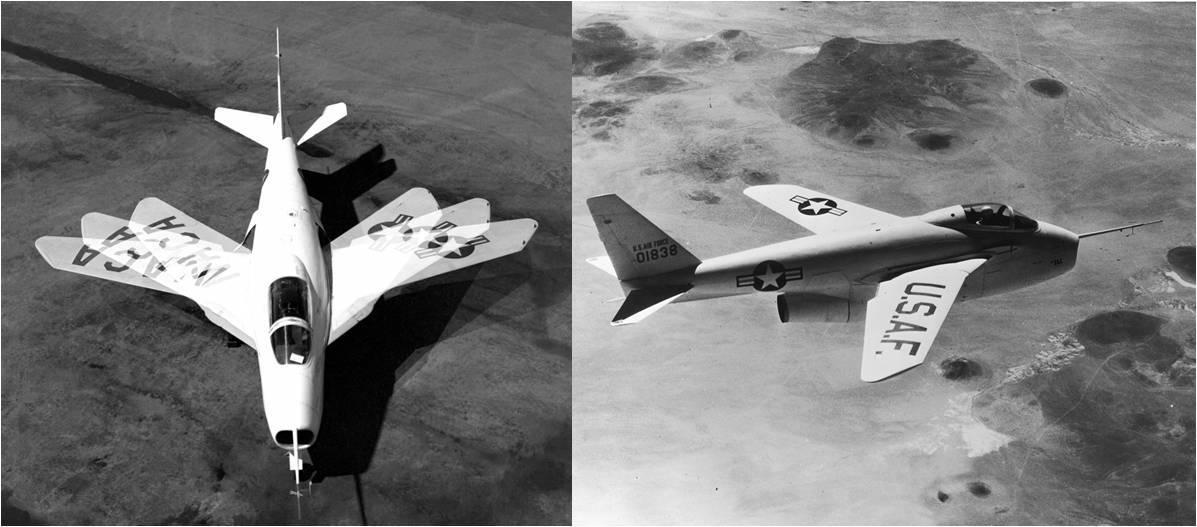Fifty-nine years ago this month, the No. 1 USAF/Bell X-5 variable-sweep-wing aircraft testbed took to the air for the first time with Bell test pilot Jean “Skip” Ziegler at the controls. The X-5 holds the distinction of being the first aircraft capable of changing its wing sweep while in flight.
The ability to change wing sweep during flight allows an aircraft to be flown more optimally throughout its flight envelope. For instance, low wing sweep enhances low-speed lift characteristics while high wing sweep reduces wave drag at high speeds. Unfortunately, these aerodynamic gains come at the price of increased structural weight and mechanical complexity.
During World War II, the Third Reich developed the Messerschmitt P.1101 aircraft which was configured with a ground-adjustable variable-sweep wing. The P.1101 was captured in 1945 by the United States as part of the spoils of war. The aircraft was subsequently transported to Wright Field in Ohio for detailed examination by American aeronautical experts.
The Bell Aircraft Corporation ultimately came into possession of the P.1101 in August of 1948 after it had been examined by the Air Force and subsequently declared as surplus by the service. After an abortive attempt to re-engine the aircraft, Bell abandoned its effort to fly the P.1101. The company then made a decision to develop a completely new variable-sweep-wing aircraft.
Bell secured a contract from the Air Force in February of 1949 to build a pair of experimental variable-sweep-wing aircraft. The new airplane joined the young X-plane family as the X-5. The tail numbers assigned by the Air Force were 50-1838 and 50-1839.
The X-5 wing sweep could be varied between 20 and 60 degrees in flight. This resulted in a wing span that varied between 33.5 feet at 20 degrees of sweep and 20.75 feet at 60 degrees of sweep. The X-5 measured 33.5 feet in length and had a gross take-off weight of 9,875 pounds. The aircraft was powered by a single Allison J35-A-17A turbojet rated at 4,900 pounds of sea level thrust.
The X-5 was a nimble aircraft. It flew as fast as Mach 0.95 and as high as 45,000 feet. In fact, the X-5 was used at various times as a chase aircraft in support of other flight test programs at Edwards. On the other hand, the X-5 was less than docile in terms of handling qualities. It was particularly unruly in a spin.
On Wednesday, 20 June 1951, the No. 1 X-5 (50-1838) took-off from Edwards Air Force Base on its first contractor flight. This aircraft would eventually accumulate 153 flights, the last of which occurred on Tuesday, 25 October 1955. A dozen men from Bell, USAF and NACA flew the X-5 during that period. The last man to fly the X-5 was none other than Neil Armstrong.
While the No. 1 X-5 (50-1838) survived the flight test program, the No. 2 aircraft (50-1839) did not. The aircraft first flew on 10 December 1951 and was lost following an unrecoverable spin on Wednesday, 14 October 1953. USAF Major Raymond Popson lost his life when he was unable to eject from the stricken aircraft. The flight was Popson’s first and last in the X-5. It is not clear how many flights 50-1839 made during its service life.
The Bell X-5 provided a wealth of performance, stability and control and handling qualities data relative to variable-sweep-wing flight. The aircraft served as the progenitor to a number of famous operational aircraft including the General Dynamics F-111 Aardvark, Grumman F-14 Tomcat, and Rockwell B-1B Lancer.
The surviving X-5 (50-1838) is currently on display at the United States Air Force Museum at Wright-Patterson Air Force Base in Dayton,Ohio.

